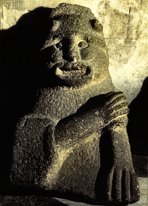|
a
HOLY DOG
and
a DOG-HEADED SAINT
St Guinefort and St Christopher Cynephoros or Cynocephalus
Anthony Weir
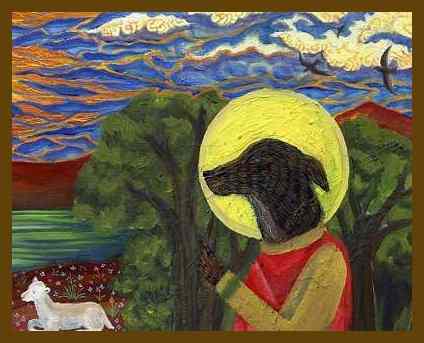
detail of Ikon painted by Artëm Kotyenko, 2000
|
The legend
of Saint Guinefort concerns
a greyhound said to have lived in mid-13th century France. Dogs
in feudal (as in Celtic) times were often highly-prized - especially
hunting-dogs. They were also a source of warmth on the baronial
bed during cold nights in unheated, cavernous and draughty stone
castles.
Guinefort, a trusted family member, was, as often happened, left
to guard an anonymous (but certainly seigneurial and almost certainly
male) infant. When the father returned he saw blood covering the
room and surrounding the infant's crib. Guinefort sat next to the
crib, with blood around his mouth. Immediately the man took his
bow and shot the dog in the heart. As the infant cried out, he realized
his tragic error, and, on approaching the crib, he saw that his
child was unharmed. Below the crib was the body of a dead snake
(Satan ?) who had been creeping up on the infant. Guinefort had
saved the child's life - and possibly his eternal life. In his grief,
the father committed the dog's body to a well and (in the ancient
Celtic tradition) planted a grove of trees around it to honour the
brave greyhound. Local peasants and villagers, when they learned
the story, began making pilgrimages to the grove to pray to the
canine martyr.
This is the international
folktale (motif B524.1.4.1.) known as The Faithful Hound.
The primary textual traditions of this particular variant - The
Dog-Saint - come from De Adoratione Guinefortis Canis (Concerning
the worship of the dog Guinefort). It somehow came to be attached
to a local Burgundian saint associated with the healing of children,
who thereby was transmogrified into a greyhound.
"This recently happened in the diocese
of Lyons where, when I preached against the reading of oracles,
and was hearing confession, numerous women confessed that they
had taken their children to Saint Guinefort. As I thought that
this was some holy person, I continued with my enquiry and finally
learned that this was actually a greyhound, which had been killed
in the following manner...[T]he peasants, hearing of the dog's
conduct and of how it had been killed, although innocent, and
for a deed for which it might have expected praise, visited the
place, honoured the dog as a martyr, prayed to it when they were
sick or in need of something..."
Étienne
de Bourbon, an inquisitor reporting from Dombes, north of Lyon
(a small area now straddling the railway-line in the département
of the Ain between Lyon and Bourg-en-Bresse), recorded the above
account in his 13th century narrative supporting Guinefort's designation
as a heretic. He had the dog "disinterred, and the sacred
wood cut down and burnt, along with the remains of the dog."
Apparently a dog cannot be an official saint, though he can be
an official heretic. Despite the best efforts of the Inquisition
to eradicate the cult of Saint Guinefort, people continued to
visit the grove up to 1940, praying for the protection of their
children. Ruins of a chapel dedicated to St Guinefort survive
at Trévron in Brittany (Côtes d'Armor). In 1987,
a movie was even made about the dog and his cult (The Sorceress,
France 1988). The 14th century Saint
Roch from Montpellier is also associated with a
dog - who, during the Black Death, stole bread from his master
for the saint when he was a plague-victim starving in the forest.
The saint's history continues, but the dog drops out of the story.
There
is an obvious connection between St Guinefort and St Christopher
who is sometimes called Cynephoros in Greek (dog-faced)
- though more often Cynocephalos (dog-headed). There are
indeed some ikons of him shown with a dog's face. These are highly
illicit - although illicitness and impropriety rarely get too
much in the way of iconographical expression. So the story of
St Guinefort is probably a popular misunderstanding of the cult
of Christopher - Christophorus Cynocephalus or Cynephoros
being easily corrupted to Guinefort. At the very least, it
was strongly influenced by the dog-headedness of Christopher.
The cynocephalic St Christopher
story also seems to have been known in England, though Old English
traditions of the saint are rather unusual. According to the Old
English Passion of St Christopher, he was healf
hundisces mancynnes, 'of the
race of mankind who are half hound'. The Old English Martyrology
elaborates upon this:
...he was thære theode wær men
habbath hunda heafod & of thære eorthan on theare æton
men hi selfe,
'from the nation where men have the head of a dog and from
the country where men devour each other'; furthermore, he
hæfde hundes hæfod, & his loccas wæron ofer
gemet side, & his eagan scinon swa leohte swa morgensteorra,
& his teth wæron swa scearpe swa eofores texas -
'he had the head of a hound, and his locks were extremely
long, and his eyes shone as bright as the morning star, and his
teeth were as sharp as a boar's tusks'.
Dogs
were highly prized in Celtic societies - at least as much as racehorses
in ours - and the Celtic legends and mythologies celebrate various
dogs called Bran. The name of the Irish hero Cú Chuailláin
means Hound of Ulster. A
Cú was
much more valuable than a Madabh (farm dog). The Welsh dog-hero/saint
Gelert, associated with Prince Llywelyn the Great (1173-1240),
is, however, a romantic fiction of the late 18th century derived
from a 5th century Indian Buddhist work, the Pancha Tantra.
The story gained wide currency in Europe in the Middle East. The
heraldic Rous Roll of the 15th century, for example, depicted
the arms of Wales as a helmet on which stand a dog and a cradle.
But it was finally applied specifically by a hotelier to the village
of Beddgelert, named after an obscure, early-mediæval, local
saint. To reinforce the story further, he erected a megalith,
Gelert's Bed. The 'new' story became the subject of a poem
by W.R. Spencer which Joseph Haydn set to music. Such is the stuff
of nationalist legend - and this is one of the more benign examples...
click here for another bogus saint with an even more amazing legend
and origin >
In
the Physiologus, the early-mediæval source of the
late-mediæval Bestiaries, dogs are praised for "having
more understanding than any other beast" - and for knowing
their name and loving their master. Dogs "are like preachers
who by warnings and by righteous living turn aside the ambushes
of the Devil...As the dog's tongue heals a wound by licking, so
the wounds of sin are cleansed by the instruction of the priest
when they are laid bare in confession." There is also
praise for dogs within dog-hating Islam.
The
Physiologus also features Cynocephaloi or dog-headed
humans.
This is a charming 16th century illustration.
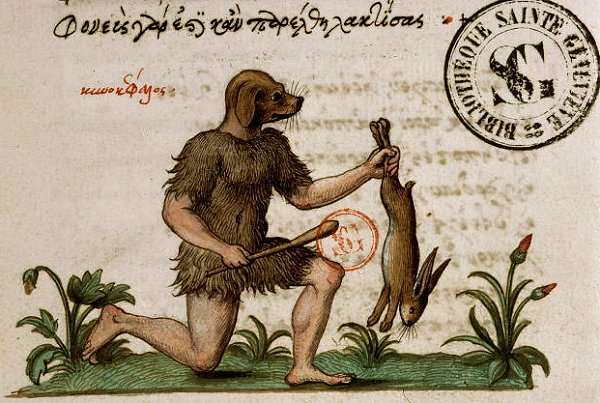
Though the myth of
dog-headed people largely derives from the depictions of the Egyptian
Jackal-god, Anubis, of whom toga-clad statues were made in Roman
times, early Greek writers reported dog-headed (shaggy ?) people
living in the Himalaya.
Romanesque
sculptors inevitably co-opted the motif, as in this fine detail
of an archivolt at Vézelay (Yonne).
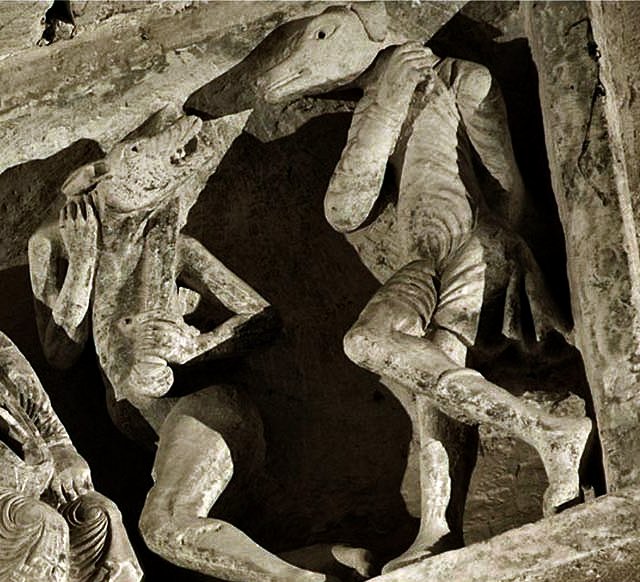
|
top of  page
page
|
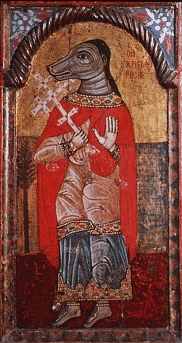
Ikon of St Christopher Cynocephalus,
from the Byzantine Museum of Athens
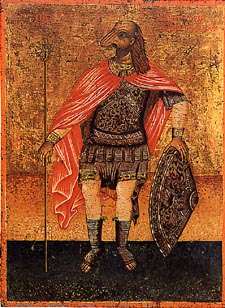
Ikon from
the Church of St. George,
Çegelköy in ancient Bithynia,Turkey.
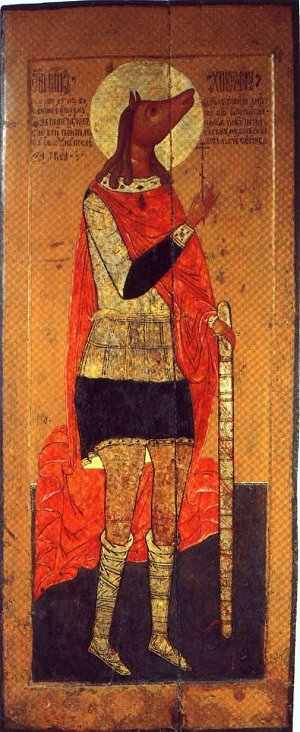
Two Russian ikons of St Christopher
(whereabouts unknown to this writer)

I
am indebted to my friend Artëm
Kotyenko of St Petersburg for bringing St Christopher Doghead to
my attention.
|
The Legend of
The Dog-headed
Saint Christopher
David Woods of University
College, Cork, has collected the essential texts in this tradition
at his St.
Christopher website. Here is an excerpt from an Irish
Passion of Saint Christopher:
Now this Christopher was one of
the Dogheads, a race that had the heads of dogs and ate human
flesh. He meditated much on God, but at that time he could speak
only the language of the Dogheads. When he saw how much the Christians
suffered he was indignant and left the city. He began to adore
God and prayed. "Almighty God," he said, "give me the
gift of speech, open my mouth, and make plain thy might that those
who persecute thy people may be converted". An angel of God
came to him and said: "God has heard your prayer."The
angel raised Christopher from the ground, and struck and blew
upon his mouth, and the grace of eloquence was given him as he
had desired.
Thereupon Christopher arose and went into the city, and immediately
began to stop the offering of sacrifice. "I am a Christian,"
he said, "and I will not sacrifice to the gods". There
came a certain Baceus to him and struck him. "You may do so",
said Christopher, "for I will not strike you in return, but
I forgive you, for forgiveness is the new law."
Baceus went to the king, and said: "Hail O King, I have news
for you. I have seen a man with a dog's head on him, and long
hair, and eyes glittering like the morning star in his head, and
his teeth were like the tusks of a wild boar. I struck him for
he was cursing the gods; but he did not strike me, and said it
was for the sake of God that he refrained. I am telling you this
in order to know what is to be done with him, for it seems that
it is by the God of the Christians that he has been sent, to help
the Christians."
"Bring him to me," said
the king. The bystanders said that a large number of men must
be sent for him. "Let two hundred soldiers go for him,"
said the king, "and bring him hither in chains; and if he resist
you, bring his head with you that I may see it."
Read
the rest of St. Christopher's life and martyrdom.
The Origin of the Cult of St. Christopher
(abridged from a text by David Woods)
St. Christopher was a member of the north African tribe of the Marmaritæ.
These inhabited the fringe of the Known World, where, tradition
had it, people were cannibals, sciapods, cyclops, hermaphrodite
or dog-headed. The latter myth derives from the appearance of baboons,
and has nothing to do with the Egyptian cult of Anubis.
Christopher was captured by Roman
forces during the emperor Diocletian's campaign against the Marmaritæ
in late 301/early 302 CE and was transported for service in a Roman
garrison in or near Antioch in Syria. He was baptised by the refugee
bishop Peter of Alexandria and was martyred on the 9th of July 308.
Bishop Peter arranged for the transport of his remains back to Marmarica
in 311. He is really identifiable with the Egyptian martyr known
as St. Menas. Insofar as the author of the lost, original
acts of St. Christopher seems both to have been based at Antioch
and to have wanted to encourage missionary activity, he is probably
identifiable as Bishop Theophilus 'The Indian', present at Antioch
circa 351-54, or as one of his circle. The fact that St.
Christopher was martyred in one place but buried in a far distant
region may explain the unusual development of his cult.
As to to the vexed question of Christopher's
real name, the name Christopher, the same in Greek and Latin, meant
"Christ-Bearer". There is no evidence to support
its usage as a first name at this early date. It was still being
used as an honorific title only, it would seem. According to the
earliest Greek passions, Christopher only took this name at his
baptism, before which he had been known as Reprebus. The
earliest Latin passion reports a similar tale except that they preserve
the name as Rebrebus. Both names look very like corrupt readings
of the Latin term Reprobus meaning "wicked". Hence
these texts seem to tell the tale of a wicked man, i.e. Reprobus,
who became a bearer-of-Christ, i.e. Christopher, and to that extent
they read suspiciously like a moralising tale rather than a factual
report. It is arguable, therefore, that St. Christopher's real name
has been lost. In so far as there exists an inscription commemorating
the dedication of a Church of St. Christopher in Bithynia (south
of the Black Sea) in 452, it is clear that it must have been lost
at a very early date. Indeed, the fact that none of the surviving
versions of the acts of St. Christopher preserve his real name suggests
that this name had already been lost before the author of the lost,
original acts composed his work based on the few surviving facts
that tradition had managed to preserve until that time.
In Russia and Finland
a different story - emanating from Cyprus - accounts for his cynocephaly:
he was so handsome that he attracted the attentions of young girls.
When he was baptised, he prayed to God that he would get such a
face that nobody would be attracted to him. God responded to his
prayers and gave him the face of a dog.
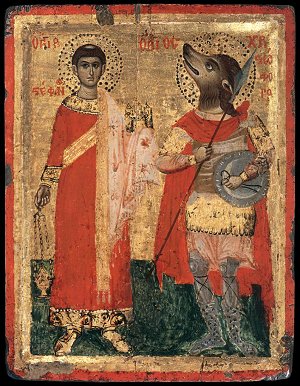
click
to enlarge
Seventeenth-century Russian ikon
of SS Stephen and Christopher.
|
read
more on ikons of St Christopher Doghead...>
click
here
to see a 20th century 'freak',
Stefan Bibrowski, alias Lionel the Dog-faced Man.
 top of top of  page
page
an
edited version of
"Holy Dogs and Asses:
Stories Told Through Animal Saints"
by Laura Hobgood-Oster, Ph.D.,Department of Religion and
Philosophy
(Brown Working Papers, Southwestern
University)
Saint Anthony,
the founder of Christian monasticism, thought he was the first
monk to live the solitary life until he heard of Paul the Hermit.
In the third century CE, Paul left human society for the desert
where he lived in a cave for sixty years. Anthony decided to find
the Hermit. As the legend goes, a wolf "came to meet him"
and proceeded to lead him to Paul's cave. The Hermit refused at
first to speak to Anthony, but finally convinced he was genuinely
seeking to be a hermit, the two embraced.
Soon, another animal entered the scene. When they started to become
hungry, a crow flew down, carrying a loaf formed of two halves.
Anthony wondered at this, but Paul told him that God provided
him daily with food: this day the quantity was doubled to take
care of the guest: the crow knew of Anthony's presence and brought
enough food for both of these early Christian saints.
[click
to read about another much-venerated desert saint]
During his time
in the wilderness, Paul's companions had all been animals. They
knew his location, led the wandering Anthony to the Hermit, provided
Paul with nourishment and served as his only companions.
Paul died shortly after the encounter with Anthony. When Anthony
returned and found him dead, he determined to bury him even though
he lacked the means. Animals again came to his service. Two lions
appeared, "dug a grave, and, when the saint was buried, went
back to the forest." This account is one of the rare appearances
of other-than-human animals in the hagiography.
Are these animal epiphanies rare or, rather, rarely noticed ?
A careful probing of the stories of the Christian tradition reveals
more animals than this religion, often classified (alongwith the
other monotheisms) as extremely anthropocentric, would seem likely
to incorporate. This paper seeks to recover a lost strand of silenced
animal voices in the history of Christianities.
After studying many written texts and examining numerous visual
representations, a framework for understanding the inclusion of
animals emerges. Animals appear as saints, as sacraments, as revealers
of the divine, as bearers of God or as Imitatio Christi
imitators of Christ. In these rôles animals act, are
acted upon, and enact the will of the divine. Amazingly ,their
agency and power, their action as subjects in their own right,
is prominent in myriad stories and is central in numerous images.
As the history of Christianity intertwined with that of patriarchal
and imperialistic Mediterranean and European powers, the dominant
forms of Christianity became increasingly anthropocentric. Animals
and their stories ceased to have a significant "voice"
in the Christian "choir."
During and after the Scientific Revolution and Enlightenment,
Christianity,
along with the majority of interlocked European cultural systems,
severed ties with the rest of nature. Thus an alienation from
any being other than the human, or the human-like divine, set
into these dominant forms of Christianity.
This intense, dualistic transformation suppressed the holy animals
within the religious tradition and its history.
Whereas the presence of animals had been integral to some aspects
of various forms of Christianity in their earlier manifestations,
the proclamations of such theologians and philosophers as René
Descartes struck the final blow to the efficacy and inclusion
of animals in the circle of religious dialogue. Humans, ascendant
for centuries, began to understand themselves as the only subjects
worthy of divine consideration. All other animals were simply
tools for human use.
Of course, this hierarchical ranking of humans over animals interlocked
by many systems of oppression that travelled with European imperialism
to the rest of the world. The binaries that place male over female,
the European "race" over all "races" of "colour,"
and mind over body, just to name a few, connect directly to the
ranking of humans over all (other) animals. As long as one of
these systems of domination remains, none of them is truly subverted.
Articulating the significant rôle that animals have played
throughout the scope of Christian
history strengthens the process of ending the interlocked dominations.
It also provides one of many perspectives that have the potential
to influence the development of a renewed, biocentric 'Christianity'.
Representation and Animals in Christianity
Distinct cultural patterns and symbol systems shape human experiences
of and relationship to other living beings in our environments.
Patterns are encoded in visual representations (a pig is presented
as a strip of bacon), in language (animals are referred to as
"it" rather than as "he" or "she")
and in daily, pragmatic ritual performances (a homeless animal
is often "put to sleep" and treated as a nuisance).
The societies that have formed around , influenced and been influenced
by Christianity in its European and North American settings have
informed many of these cultural patterns and symbol systems in
profound ways. Animals are regarded as subordinate, irrational,
soul-less beings whose primary purpose is based on a theory of
utilitarianism that places human beings at the top of a hierarchy.
Animals exist for human consumption, labour and æsthetic
or emotional pleasure alone. Intrinsic value and direct relationship
between animals and the sacred is denied.
But has this cultural pattern been static, or has some transformation
of understanding occurred ? Did animals once engage humans and
God, within 'Christianity',
differently? If so, why would it matter or what could it affect
? The thesis that I offer is based on recovering an understanding
of the relationship between humans and animals within the history
of Christian traditions. Do certain patterns suggest cultural
continuities and shared symbols ? Are animals legitimised or denigrated
in the sacred history of this multi-faceted religious tradition
? What developments are linked to changes in these representations
and experiences of human and animal ? What transformations take
place in these relationships and how do these point toward other
historical patterns?
In this paper I will address the first two questions in particular
and suggest possible directions for continued research and analysis.
Christianities grew out of the various religious traditions found
in the Mediterranean world two thousand years ago. Judaism, mystery
religions, myriad pagan traditions and the official religion [was
there one ??? A.W.] of the
Roman Empire, to name just a few, provided the primary sources
for early forms of Christianity. As they develop, Christianities
incorporate various aspects of these traditions and their belief
systems. From this process a rather ambiguous place is forged
fo animals in Christian traditions. Each of these religious traditions
included and excluded animals in various ways, thus influencing
the foundations for the inclusion and exclusion of animals in
Christianities.
But Christianity, in its formalised, official and primarily patriarchal
structure does not take other-than-human animals seriously. The
major theological works of such figures as Thomas Aquinas, John
Calvin and Karl Barth, the central doctrines and creeds of the
both the Roman Catholic and Orthodox churches as well as the primary
themes of the Protestant world focus on human beings and the human
relationship with the divine. Humans are of ultimate concern,
with little or no regard for other animals. The culmination of
the anthropocentric model in constructive theology and philosophy,
as well as anthropocentric scriptural exegesis, melded with the
philosophy of the Enlightenment to conclude that a fundamental,
essential, divinely-ordained difference exists between humans
and animals.
[This is in contrast to post-mediæval attitudes
to handicapped children. Mediæval thinkers, notably including
Martin Luther, were convinced that they were changelings and hence
non-human. Thus they could be killed, beaten and tortured without
any sanction from society. Gradually, however, the changeling
legends (which involved fairies, who were fallen male angels who
had by God's mercy escaped Hell, but could not reproduce) came
to be seen as preposterous. For a while Roma people (Gypsies)
- themselves regarded, and still regarded, with the deepest suspicion
- took on the rôle of the child-snatching-and-substituting
Fairies. - A.W.]
Yet various sources tell a different story, reveal a different
image. The artwork, hagiography, oral traditions (later recorded
in written form) and important legends reveal a close connection
between humans and the natural world. Stories and images of animals
abound. I suggest that these animals are not always or only symbolic
or metaphoric but are often subjects, agents in the complete sense.
Images and narratives contain multiple encodings and decodings.
Oftentimes the animals presented in words and images are sacred,
and play an active rôle in the revealing of the holy.
What is the context for animal saints and why, over the course
of the last few centuries, have these stories disappeared ? It
could be argued that most of the examples presented here are stories
of animals with saints, not animals as saints. However,
when one attends to the rôles of the actors, particularly
the active rôles of the animals in these stories, the rôles
are often reversed. Through their agency animals subvert the "power"
and "control" of the human saint and elevate the status
and piety of the animal saint.
Who is the saint or who are the saints in each story? That is
sometimes left to the interpretation of the hearer of the story,
seer of the image or witness to the event. The primary sources
for these stories are the lives of saints from the 2nd century
to the 16th century CE and religious images throughout the Christian
areas of Europe during the same period. The religious imagery
on which the paper, as well as my other work, focuses is popular
art, displayed in churches where masses of common people see and
interpret its meaning. A tracing of these stories and images suggests
that certain patterns reveal cultural continuities and shared
symbols. The four patterns that I address are: animals as exemplars
of piety, animals as sources of revelation, animals as saintly
martyrs, and animals as the primary intimate other in relationship.
Animals as exemplars of piety
Lions abound in Christian legend and symbol. For centuries lions
stood on either side of many bishops' seats in cathedrals and
framed the doors of many churches, including the church in which
the young St. Francis was baptized - San Ruffino in Assisi, Italy.
One of the most amazing lions appears in the Acts of Paul. An
early fragment, in Coptic, tells of a lion approaching Paul as
he prayed. The lion lay down at the apostle's feet and Paul, never
missing an opportunity to convert, asked the lion what he wanted.
The lion replied, "I want to be baptised." Paul
took him to a river and immersed him three times. The lion then
greeted Paul with "Grace be with you!", then
departed into the countryside. Baptism, the Christian sacrament
that confirms an active choice of belief and that initiates one
into the Christian community, is requested by and granted to a
lion.
Lions also provide protection for Thekla, a companion of Paul
in his journeys. At her martyrdom the beasts which were to tear
her to pieces were exhibited. Then she was bound to a fierce lioness...And
the lioness, with Thekla sitting upon her, licked her feet; and
all the multitude was astonished...And Thekla...was stripped and
received a girdle and was thrown into the arena. And lions and
bears were let loose upon her. And a fierce lioness ran up and
lay down at her feet...
A series of animals, some of whom meet their own demise, encounter
Thekla during the numerous attempts to execute her. Eventually
the lioness dies protecting her. One question, based on Paul's
choice to baptise a lion by water, is whether the lioness who
dies defending Thekla earns actual martyr status.
And what about
the inclusion of animals in other central Christian sacraments,
particularly the Eucharist? Apparently, animals have been invited
to partake in this ritual as well. In Donatello's image, the scene
is the celebration of the Eucharist, the central act of many forms
of Christian worship, and of a mule kneeling before the host,
the body and blood of Christ.
Saint Antony of Padua, considered to be the greatest preacher
of his time, was a young Franciscan who preached to fish much
as his predecessor, Saint Francis, preached to the birds. The
miracle of the mule suggests the incorporation of animals into
both the liturgy and the sacramental life of the Church. The image
appears in highly acclaimed works of art, such as Donatello's
bronze sculpture in a church in Padua, and on the walls of baptisteries
frequented by the most common of people, such as the Baptistery
in Siena.
A similar pattern is revealed throughout the stories of the life
of St. Francis of Assisi. Many animals are connected with him,
and the many artistic renderings of his life include birds, wolves
and donkeys in company with the saint. Even images of Francis
in ecstasy, at the height of mystical union with the divine, include
animals. But a particularly poignant tale reveals the piety of
the birds: "As St. Francis spoke these words to them,
all those birds began to open their beaks, and to stretch out
their necks, and to open their wings, and reverently to bow their
heads to the ground, and to show by their motions and by their
songs that the holy father had given them very great delight.
St. Francis rejoiced with them and was glad and marvelled much
at so great a multitude of birds, and at their most beautiful
diversity, and at their attentiveness and fearlessness, for which
he devoutly praised the Creator in them."
An "infinite multitude" of birds, [Francis addresses
them as "little sisters"]
gather and attentively listen to Francis as he preaches about
their blessedness and their need to praise God. ccording to two
of Francis's biographers, he "blessed them, and having
made the sign of the cross, gave them leave to fly away to another
place...nor did one of them move from the spot until he made the
sign of the cross over them and gave them leave." Upon
leaving, another symbol of piety emerges as "all those
birds soared up into the air with wondrous songs and then divided
themselves into four parts after the form of the cross Saint Francis
had made over them." The birds then proceed to announce
their own belief: One flock flew toward the East, and one toward
the West, and one toward the South and the fourth toward the North.
And each flock went singing marvellous songs.
One of the primary scenes attesting to animals as exemplars of
piety is also one of the most powerful symbolic-visual sets of
images in Christian history stories of the nativity of Jesus.
These stories include images of adoring animals surrounding the
manger. Cattle, sheep donkeys and the occasional dog or horse,
prove uncanny in their ability to recognize the revelation of
incarnation of the nativity. Indeed, some images depict humans
as much less aware of the nature of the incarnation than were
the animals.
Animals as sources of revelation
Animals have also been direct sources of revelation-messengers
of the divine to human beings. Most particularly, animals have
been the bearers or carriers, of the incarnation of the sacred
- the bearers of Christ.
While hunting one day, a Roman soldier, Placidus, came upon a
herd of deer. One of these, a large stag, impressed the soldier
with his incredible size and beauty. As the stag ran into the
dense woods, the soldier approached pondering how to capture this
animal. Suddenly he noticed a cross with the image of Jesus between
the antlers of the deer. The voice of the divine came from the
stag's mouth and said: "O Placidus, why are you pursuing
me? For your sake I have appeared to you in this animal. I am
the Christ, whom you worship without knowing it. I have come,
that through this deer which you hunted, I myself might hunt you."
The next morning, the vision appeared to him, again with the stag
as the vehicle for revelation. The soldier changes his name to
Eustace and becomes a Christian.
His hagiography relates yet another animal saint. Years later
when Eustace was displayed in the arena for martyrdom, a ferocious
- and very hungry - lion served as the imperial death weapon of
choice. But the lion came out peacefully, lowered his head and
adored the soon-to-be martyrs rather than kill them. There are
other similar stories.
St. Francis Xavier recounted (or invented) his own peculiar animal-aided
vision of the divine. During a mighty storm in the Moluccas, Xavier
tried to calm the waves by holding his crucifix over them, but
a huge wave swept it overboard. Once safely on shore, Francis
saw a large crab coming towards him, carrying the cross in his
pincers.
Animals as martyrs and servants
The most striking images of animals in the hagiography are those
of animals as martyrs or servants.. Following the example set
by Jesus, martyrs claimed a second and ultimate baptism in blood.
Their stories were told throughout Christianities to strengthen
the commitments of believers facing oppression. But some of these
martyrs are, not just symbolically, but literally sacrificial
lambs.
One of the most fascinating martyr-saints is Saint
Guinefort. The stories of his heroic martyrdom (above)
and of the healings that took place at his shrine influenced generations
of believers in Southern France.
In the year 406, Paulinus, a monk and a priest, read a poem honouring
St. Felix on his birthday. The poem features animals as the principal
characters in a series of miracle tales. Christianity had denounced
animal sacrifice, primarily as a sign of differentiation from
Roman religious systems. But the rituals continued, particularly
in rural areas. At the tomb of St. Felix, in southern Italy, the
practice had been Christianized and served as a way to distribute
food to the poor who would gather at the tomb to collect meat
from the sacrificed animals.
The first tale is of a horse "seemingly endowed with human
reason" who provided a "holy sign" and became a
"source of wonder for those in attendance." This inspired
horse intervened as his master attempted to take the best portions
of a hog that he had sacrificed rather than leave them for the
poor. The equine saint threw the greedy man to the ground and
then carried the sacrifice back to the tomb. Power and compassion
are central to this horse-saint's piety.
A second story comes from this same tradition and relates the
miracle of a rather plump pig. She had been vowed to Felix at
birth, but because of her girth she was unable to walk the distance
to the shrine. Her masters took two smaller piglets in her place,
but when they arrived, the pudgy pig was already on the altar
offering herself as sacrifice. Obviously, the sacred had been
revealed in and through the pig who, by some accounts, placed
her throat on the blade, willingly offering her life as food that
others might live.
A similar story tells of a heifer who walks without a halter to
the altar and "undefiled by the yoke and offering its
neck to the axe, about to provide food for the poor from its slaughtered
body, joyously it poured out its blood in fulfilment of its masters'
vows."
Parallels between the sacrificial rôle of these animals
and that of the figure of Jesus, particularly in their theological
connotations, prove both striking and potentially controversial.
Of course, the lamb is a pervasive visual and liturgical symbol
of sacrifice and piety, oftentimes replacing the figure of Jesus
and other disciples. A beautiful example is the seventh century
apse of Sant' Apollinare in Classe that portrays all of the twelve
traditional disciples as sheep.
So the symbol of the animal as sacrificial victim and even as
saviour is central to Christianity. But the stories of St. Felix
move these animals into active rôles, symbolic and actual
in their life of sacrifice.
Another common theme of animals as servants comes at the time
of death and burial. A story similar to that of Saints Paul and
Anthony tells of another lion assisting in the burial of a saint.
St. Mary of Egypt, a hermit and ascetic, had lived in the desert
for years, eating only bread and lentils. A monk, Zosimus, came
across this figure of holiness as he traversed the desert. One
year, he served her the Eucharist and promised to bring this sacrament
to her the next year as well. When he came back, he found her
dead. Zosimus tried to dig a grave but could not. Then he saw
a lion meekly coming toward him and said to the lion: "This
holy woman commanded me to bury her body here, but I am old and
cannot dig, and anyway I have no spade. If you could do the digging
we will be able to bury this holy body together."
The lion began to dig and prepared a suitable grave, and when
that was finished went away "like a gentle "lamb.
Even arachnids seem to hear the voice of God without hesitation
- for another story connected to a saint named Felix includes
spiders as heroes. While preaching, Felix, a bishop, found himself
being pursued by persecutors, so he proceeded to hide:...he slipped
through a narrow opening in the wall of a ruined house and hid
inside. In a trice, by God's command, spiders spun a web across
the space. The pursuers, seeing the web, thought that no one could
have gone through the opening, and went on their way. Later Felix
was killed by a group of boys he taught. Boys can be less compassionate
even than spiders.
Animals as primary other in relationship to humans
Finally, there are numerous stories of animals as the primary
other in relationship to humans throughout the Christian tradition.
Obviously many of the hermits and desert dwellers mentioned throughout
are in the company of an animal or animals. In addition, anchoresses
who lived cloistered, often as solitaries, would be permitted
one cat in their cell. But one of the most popular stories of
saint-animal companionship is that of St. Jerome, a Father of
the Church who lived in the wilderness, probably close to Bethlehem,
while translating the Bible from Greek into Latin. He lived with
some other monks, and many animals including dogs ,hens, sheep
and donkeys.
One day, a great lion came into
the monastery courtyard. Needless to say, all the monks scattered,
except for Jerome. He noticed that the lion was limping and welcomed
him in the spirit of hospitality that pervades most monasteries.
Jerome healed the lion, who decided to remain with Jerome.
The adventures of Jerome and the lion continue, but suffice it
to say that on the death of the saint, the lion, a saint in his
own right,is said to have grieved without ceasing.
This is not the only such account. The story of St. Giles and
the hind is tender and tragic. Giles, who had cured many, became
a solitary living in a cave close to a beautiful spring. But he
was only a solitary in terms of his relationship with people,
because as the story goes "for sometime he was nourished
with the milk of a hind" or doe. Eventually, a group of hunters
pursued her and she took refuge with St. Giles in his cave. She
was "whining and whimpering ... not at all like her"
so Giles went out and, hearing the hunt, prayed that God would
save this doe, the "nurse" whom God had provided. This
happened again and again, until finally, on the third day, the
king brought a bishop along with him to survey the situation.
This time "one of the huntsmen shot an arrow into the cave,"
wounding St. Giles as he knelt in prayer for the life of the doe.
St. Blaise, a bishop, also decided
to live the life of a hermit. He "retired to a cave"
where "birds brought him food, and wild animals flocked to
him." These animals would not leave "until he had laid
hands on them in blessing." This action indicates that Blaise
understood the animals worthy of blessing and the animals understood
the significance of the ritual. In addition, Blaise offered them
healing and "if any of them were ailing, they came straight
to him and went away cured."
Conclusions
Can animals be counted among the
saints in Christianity? They have served as the locus for revelation,
been examples of piety, offered themselves as martyrs and servants,
and, in their relationships with others, have been the source
of agape - divine love. Thus, the sacred history, though often
obscured, suggests that animals may indeed be counted among the
holy ones in the Christian tradition.
Of course, the functional world-view
for these animal-human-divine relationships reveals a significantly
different historical context in many cases. Humans and animals
were intimately related in everyday life during the periods when
these stories were developed. In contrast Euro-American culture
of the early twenty-first century is a culture alienated from
the natural world and other animals in most manifestations. Popular
images of animals have morphed into human projections on a vast
scale-from Disney's mawkish sentimentalities such as Bambi
or The Lion King, to cultic-pornographic pedigree dog
shows, to mass produced flesh for food, with the actual dead animal
being an utterly-absent referent.
These differences could, arguably, render the relevance of such
animal stories impotent. But even in those different cultural
contexts saints provided an alternative relationship. Andrew Linzey,
one of the few contemporary theologians to address the issue of
animals, suggests this possibility in his book Animal Theology:
"We need to remember that the challenge of so many saints
in their love and concern for even the most hated of animals,
was in almost all cases against the spirit of their times..."

|
AN
ISLAMIC VIEW
from "How
to become Holy"
written in 1453 by Abu Abdallah
Muhammad Al-Jazuli Al-Simlali.
In
order to eliminate feelings of self-importance, he who would become
holy would do well to acquire the Ten
Praiseworthy Attributes of the Dog:
1. He sleeps only a little
at night; this is a sign of the God-lover.
2. He complains of neither
heat nor cold; this is a sign of patient endurance.
3. When he dies, he leaves
nothing behind to be disposed of; this is a sign of asceticism.
4. He is neither angry nor
hateful; this is a quality of the faithful.
5. He is not sorrowful at the
loss of a close relative, nor does he accept assistance; this
is an attribute of the unshakeable.
6. If he is given something,
he consumes it and is happy; this is a sign of the never-demanding.
7. He has no known place of
refuge; this is the quality of holy wandering.
8. He sleeps in any place that
he finds; this is a quality of the never-complaining.
9. He is incapable of hate,
even if his owner beats or starves him; this is a quality of
the knowers of wisdom. (Compare the injunction
in the Hindu Upanishads: "Be like the sandalwood that
perfumes the axe that hacks it.")
10. He is always hungry, which
is a sign of the virtuous.
These attributes were amongst those of the black (therefore despised)
Moroccan saint, Abu
Yi'zza.
|
Rejoice
in the Dog >>
The
Parable of Lazarus >>
Saint
Onouphrius of the Desert >>
An
Albanian Ikon >>
The
Nature of Christianity >>
more
on Cynocephaly >>
This web-page is dedicated to the memory of Saint
Oscar the Curly-tailed.

|
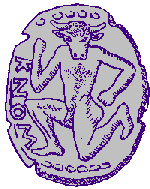
![]()

